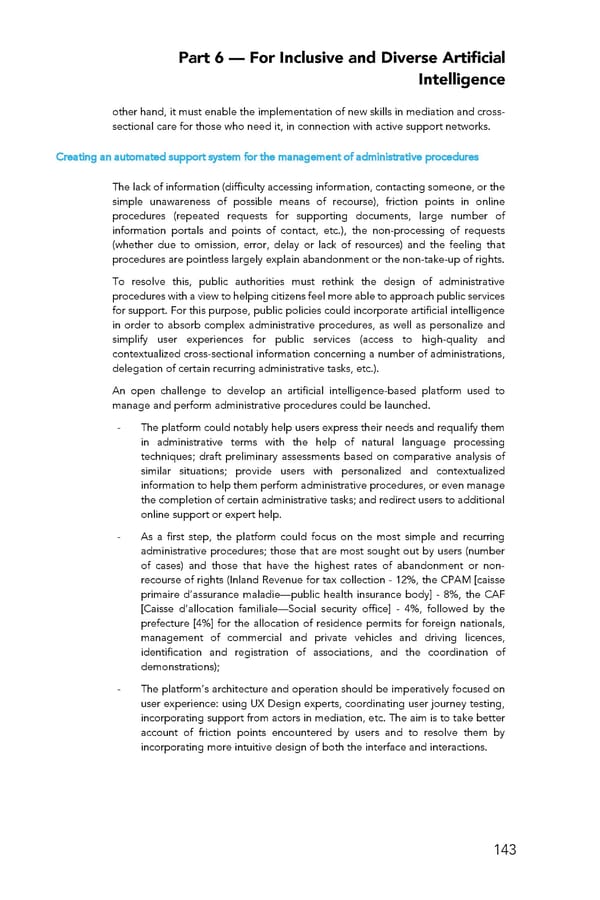Part 6 — For Inclusive and Diverse Artificial Intelligence other hand, it must enable the implementation of new skills in mediation and cross- sectional care for those who need it, in connection with active support networks. Creating an automated support system for the management of administrative procedures The lack of information (difficulty accessing information, contacting someone, or the simple unawareness of possible means of recourse), friction points in online procedures (repeated requests for supporting documents, large number of information portals and points of contact, etc.), the non-processing of requests (whether due to omission, error, delay or lack of resources) and the feeling that procedures are pointless largely explain abandonment or the non-take-up of rights. To resolve this, public authorities must rethink the design of administrative procedures with a view to helping citizens feel more able to approach public services for support. For this purpose, public policies could incorporate artificial intelligence in order to absorb complex administrative procedures, as well as personalize and simplify user experiences for public services (access to high-quality and contextualized cross-sectional information concerning a number of administrations, delegation of certain recurring administrative tasks, etc.). An open challenge to develop an artificial intelligence-based platform used to manage and perform administrative procedures could be launched. - The platform could notably help users express their needs and requalify them in administrative terms with the help of natural language processing techniques; draft preliminary assessments based on comparative analysis of similar situations; provide users with personalized and contextualized information to help them perform administrative procedures, or even manage the completion of certain administrative tasks; and redirect users to additional online support or expert help. - As a first step, the platform could focus on the most simple and recurring administrative procedures; those that are most sought out by users (number of cases) and those that have the highest rates of abandonment or non- recourse of rights (Inland Revenue for tax collection - 12%, the CPAM [caisse primaire d’assurance maladie—public health insurance body] - 8%, the CAF [Caisse d’allocation familiale—Social security office] - 4%, followed by the prefecture [4%] for the allocation of residence permits for foreign nationals, management of commercial and private vehicles and driving licences, identification and registration of associations, and the coordination of demonstrations); - The platform’s architecture and operation should be imperatively focused on user experience: using UX Design experts, coordinating user journey testing, incorporating support from actors in mediation, etc. The aim is to take better account of friction points encountered by users and to resolve them by incorporating more intuitive design of both the interface and interactions. 143
 For a Meaningful AI - Report Page 141 Page 143
For a Meaningful AI - Report Page 141 Page 143